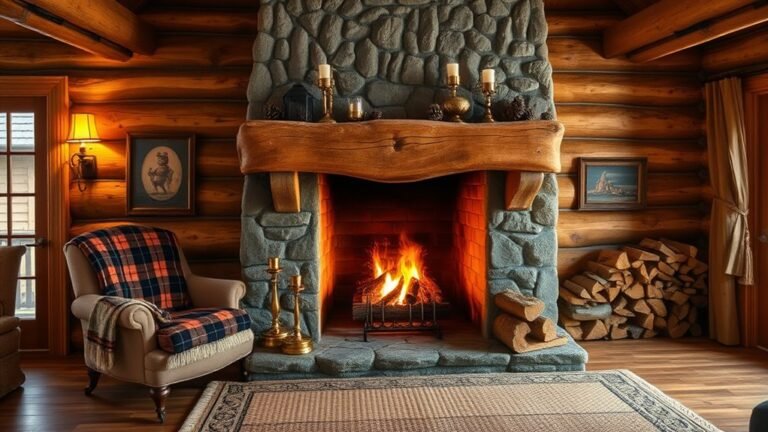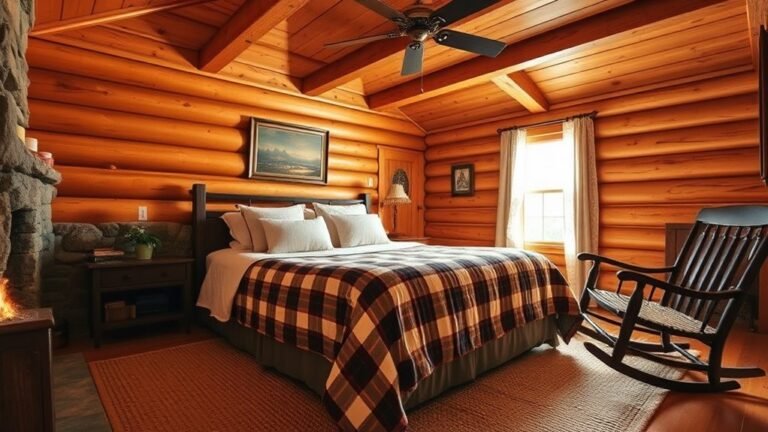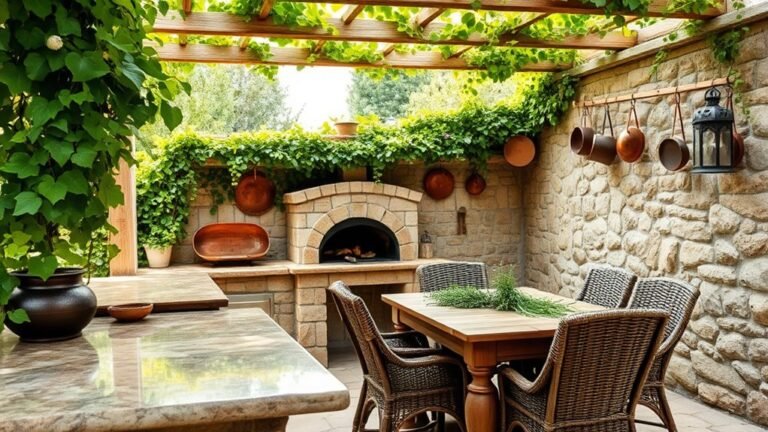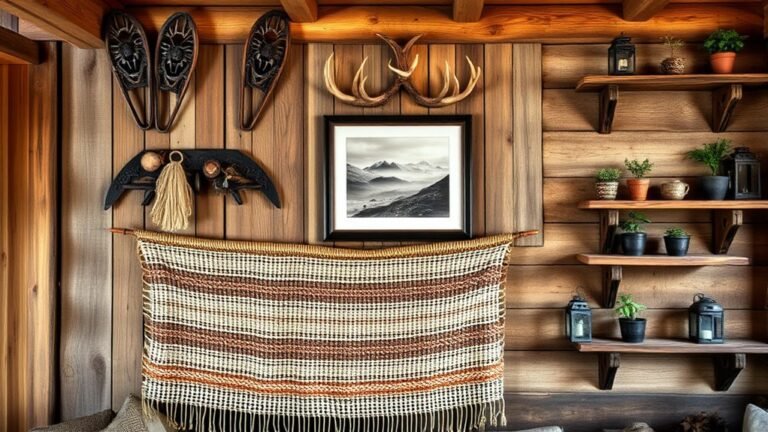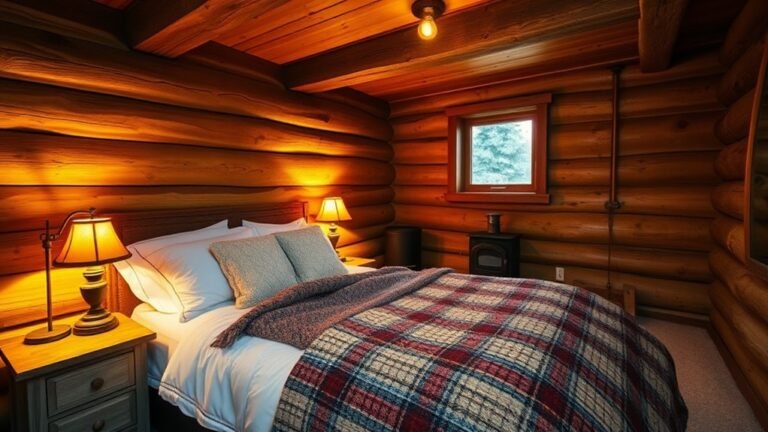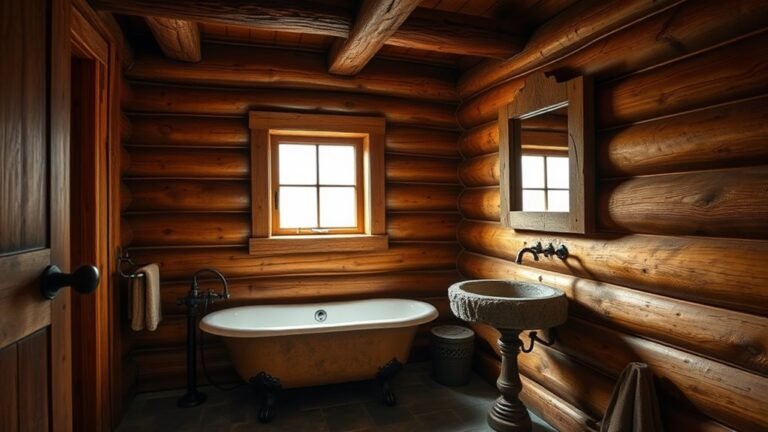17 Rustic Interior Design Mistakes to Avoid
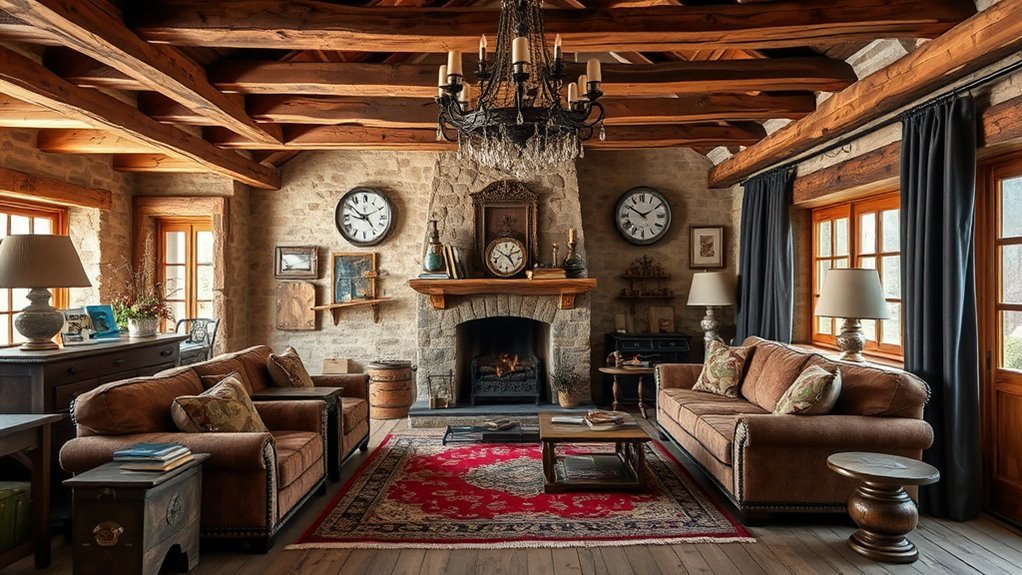
Rustic interior design requires a balance between charm and chaos, where subtle missteps like excessive decor and inadequate lighting can undermine your vision. To ensure your space exudes warmth and personality, be mindful of these common pitfalls.
Achieving a perfect rustic retreat begins with recognizing potential design errors. By addressing these issues, you can create a space that truly radiates the rustic charm you desire.
Overloading With Decor
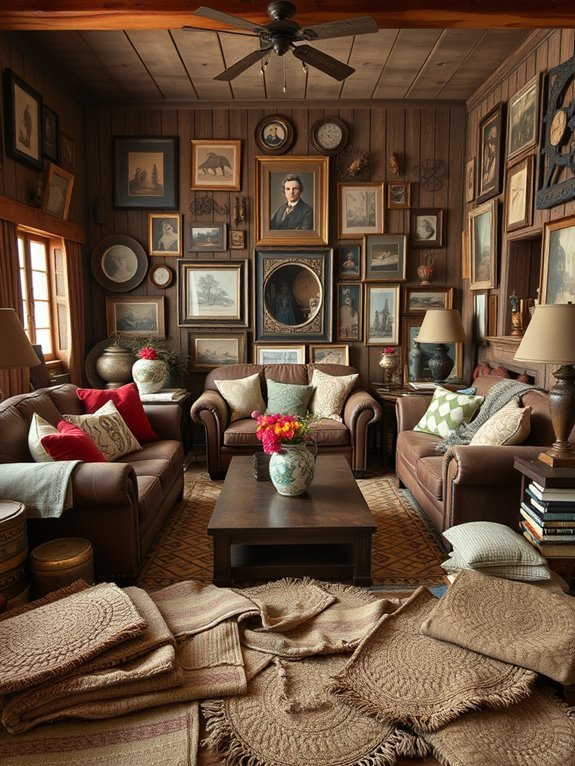
Creating a rustic interior can quickly lead to clutter if you’re not careful. Instead of overloading your space with vintage signs, excess throw pillows, and competing wall art, focus on a few standout pieces that embody rustic charm. A statement piece, like a reclaimed wood coffee table, should take center stage. Complement it with carefully chosen accessories, such as a quirky antique clock or a woven basket. Incorporating faux animal hides can enhance the rustic decor, adding a touch of wilderness to the interiors while maintaining easy maintenance.
Ignoring Natural Light
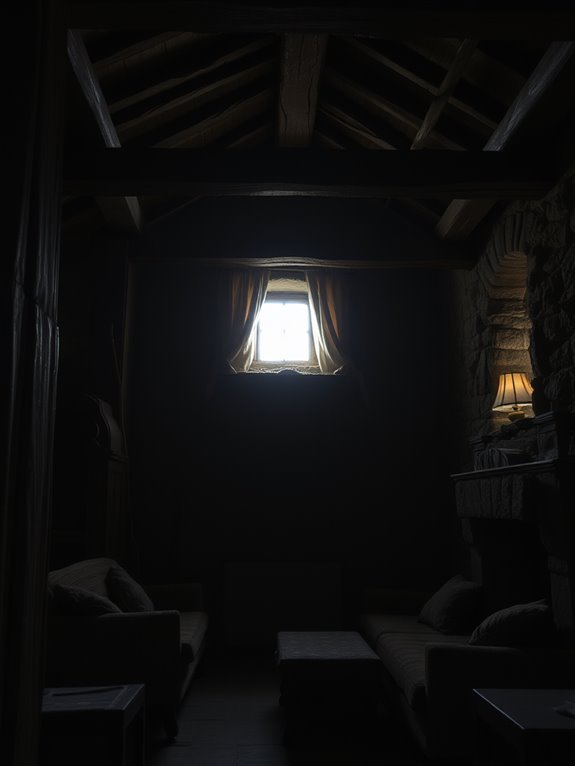
Appreciating rustic design requires embracing natural light—it’s like trying to enjoy a sunset in a dark room otherwise.
Natural light enhances rustic spaces by highlighting wood’s warm tones and stone textures. Avoid blocking windows with heavy drapes or furniture; instead, choose light curtains or leave windows bare to enjoy the view.
Large windows can serve as focal points, creating a cozy yet spacious atmosphere. Use mirrors to reflect light and brighten rooms. Incorporating nature-inspired decor elements such as lanterns or nature-inspired artwork can further enhance the ambiance by connecting indoor spaces with the natural environment outside.
Natural light not only adds style but boosts mood, preventing a gloomy home.
Choosing Incompatible Colors
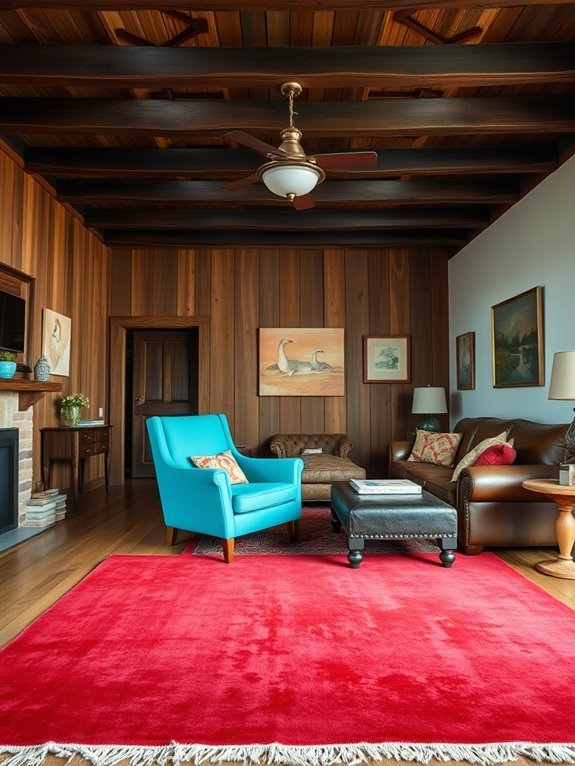
Many homeowners underestimate the importance of color compatibility in rustic design, often resulting in a mismatched and chaotic appearance. To avoid this, think of your colors as parts of a cozy quilt, where each piece complements the others. Opt for earthy tones like browns, greens, and muted reds to evoke nature and warmth, ideal for a rustic vibe. Avoid bright neons or overly bold colors, as they disrupt the tranquility of the space. Stick to a harmonious palette by using adjacent shades on the color wheel for seamless flow or combining warm and cool tones for interest. If unsure, compare paint swatches to ensure compatibility. Incorporating natural materials like wood and stone can further enhance the rustic appeal and create a cohesive look with your chosen color scheme.
Misjudging Scale and Proportion
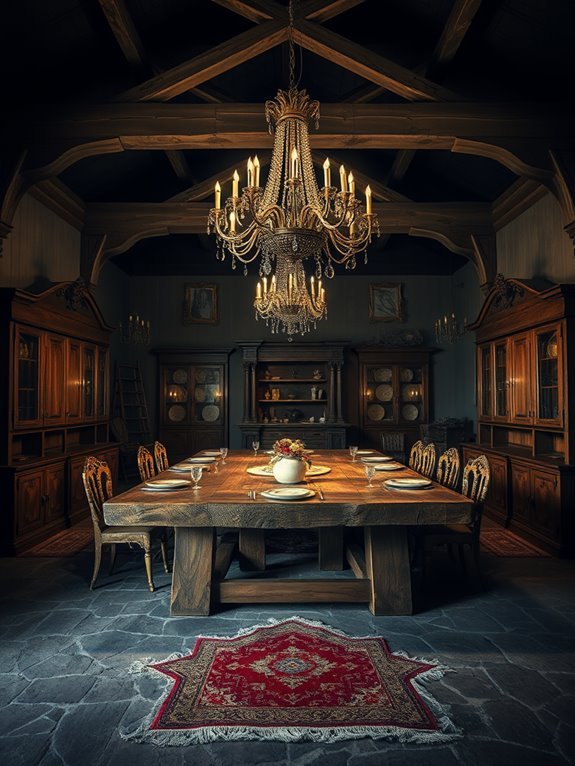
When designing a rustic interior, it’s crucial to consider scale and proportion to avoid furniture and decor that feel out of place.
For example, squeezing a massive farmhouse table into a small dining nook can make the space feel cramped. Here are some tips to avoid this:
- Measure First: Use a tape measure before purchasing anything to prevent surprises.
- Balance Sizes: Mix large pieces with smaller ones, like pairing a large couch with petite side tables for balance.
- Consider Ceiling Height: Tall shelves or light fixtures suit high ceilings, while low ceilings need more subtle decor.
- Group Items Wisely: Arrange decor by varying the size and height of each piece to create visual interest without overwhelming the space.
Skipping Texture Variety
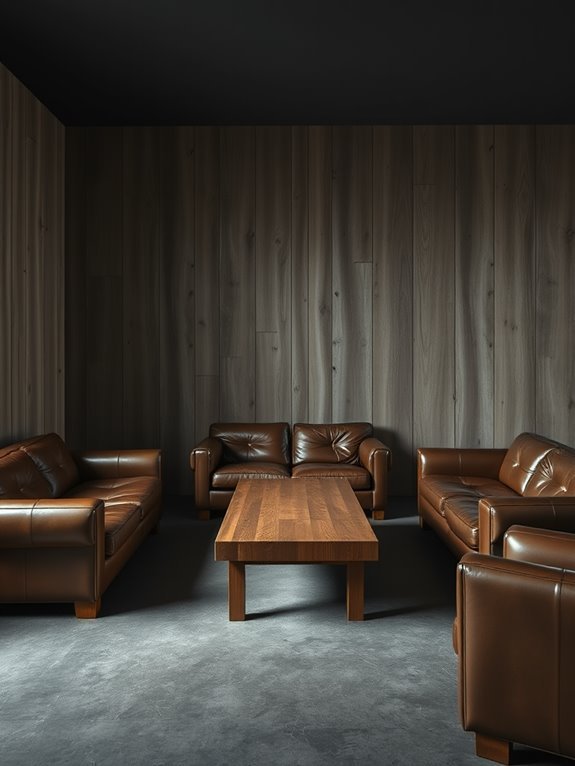
Neglecting texture variety can make a rustic interior feel flat and uninspired. Sticking to one or two materials might seem easier, but it’s a missed opportunity.
Your space needs a mix of textures to stay lively and engaging. Imagine the warmth of a wooden beam next to a soft, woven rug, or the contrast of a rough stone wall against smooth leather furniture.
Skipping texture variety risks creating a space that feels more like a museum than a cozy home. So, don’t hesitate! Layer materials like reclaimed wood, burlap, metal, and ceramics. Each brings charm and visual interest.
A space that invites touch and exploration is always appealing. You’ll want to feel that chunky knit throw or rustic pottery.
Plus, adding texture creates a play of light and shadow, making your rustic interior dynamic and inviting. Mix it up, and watch your space transform from drab to fab! Your home will thank you.
Neglecting Functional Layout
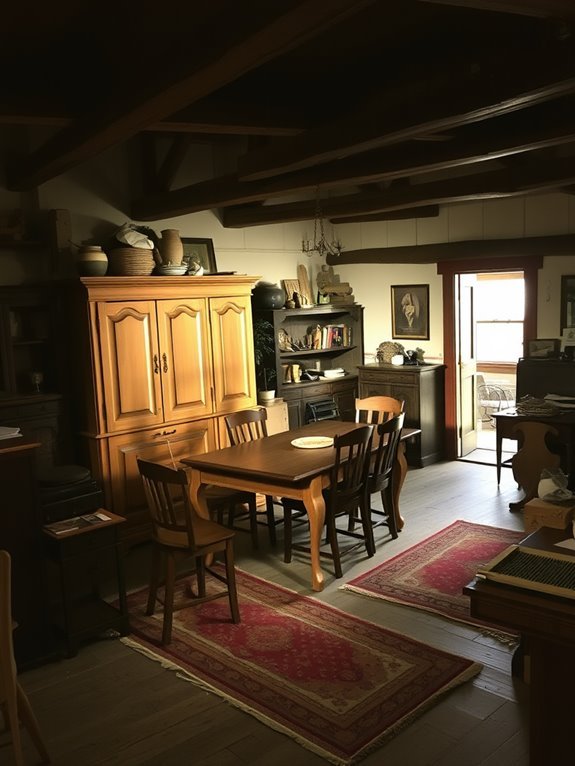
A functional layout is crucial for a cozy rustic space. Neglecting it can turn your haven into chaos.
Here are four tips to maintain functionality and charm:
- Prioritize Flow: Arrange furniture for easy movement, preventing tripping hazards.
- Group Similar Items: Cluster seating for cozy conversation areas.
- Consider Scale: Choose furniture sizes that suit the room.
- Incorporate Storage: Use rustic solutions like baskets and wooden crates for neatness.
Using Too Many Patterns
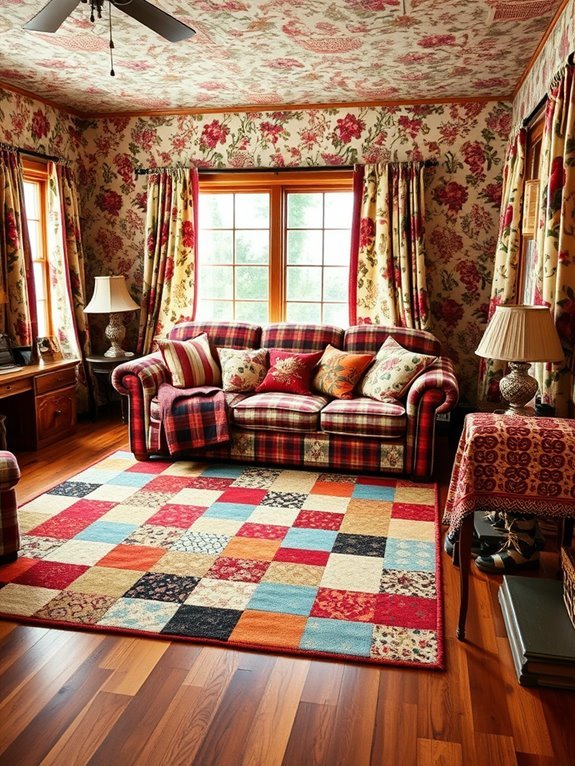
To create a harmonious rustic interior without overwhelming the senses, avoid using too many patterns.
While a plaid throw and floral cushions can add coziness and charm, mixing them excessively can create a chaotic space.
Instead, choose a few key patterns with complementary colors and styles that align with the rustic theme, like a checkered pattern paired with a muted, nature-inspired print.
This approach ensures a cohesive, warm, and inviting look without visual competition.
Overlooking Quality Materials
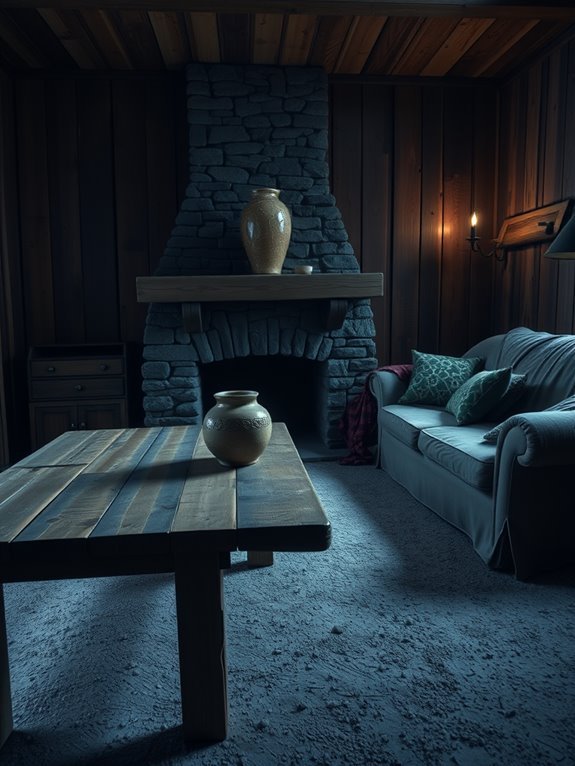
Balancing patterns is just one part of achieving a rustic interior; material quality is crucial too.
Skimping on costs with cheap materials can undermine the cozy vibe. Instead, invest in quality pieces that last and look great.
Focus on these materials:
- Wood: Choose reclaimed or solid wood for character and durability.
- Textiles: Opt for natural fibers like cotton, linen, or wool for comfort and a rustic feel.
- Stone: Use stone in flooring or feature walls for an earthy touch.
- Metal: Select wrought iron or antique bronze for light fixtures and accents to add authentic rustic charm.
Forgetting About Comfort
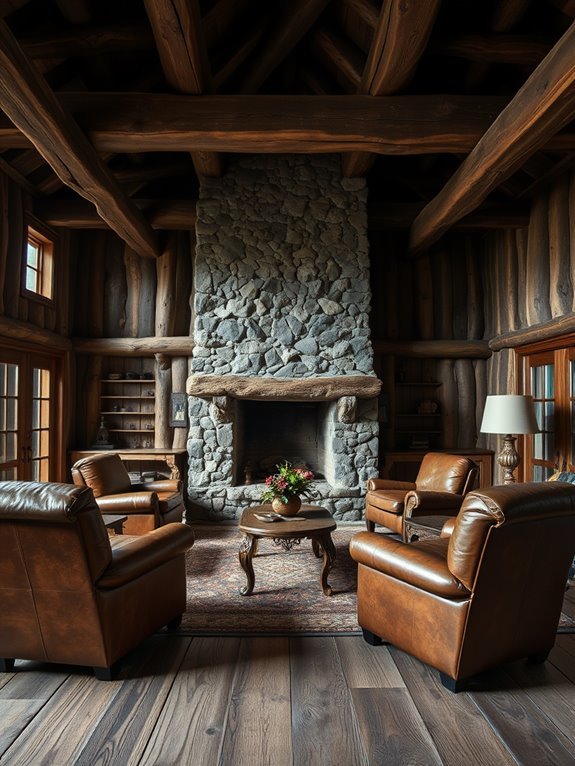
In rustic interior design, comfort often gets overlooked in favor of aesthetics. While a reclaimed wood table may look stunning, it should also be functional. Your space should feel cozy and inviting, not like a showroom.
Choose furniture for its usability; antique chairs might be stylish but not if they’re uncomfortable. Opt for pieces that combine style and comfort, like a soft, oversized sofa for relaxation.
Don’t neglect textiles—plush throws and comfy cushions can make a space feel warm and inviting, and they’re a great excuse to add that cute knitted blanket to your decor!
Disregarding Architectural Features
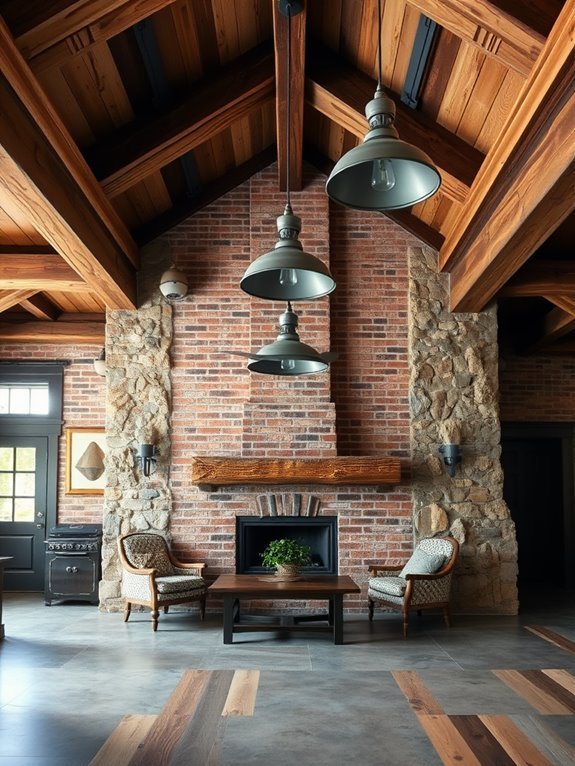
In designing a rustic interior, embrace architectural features to ensure a cohesive, inviting look.
Here are key tips:
- Highlight Exposed Beams: Flaunt them for added character and warmth.
- Showcase Stone Walls: Let natural stones be the focal point.
- Incorporate Natural Light: Use big windows or unique lighting to enhance the rustic vibe.
- Respect Original Flooring: Preserve original hardwood, tile, or rugs for authenticity.
Mixing Styles Inconsistently
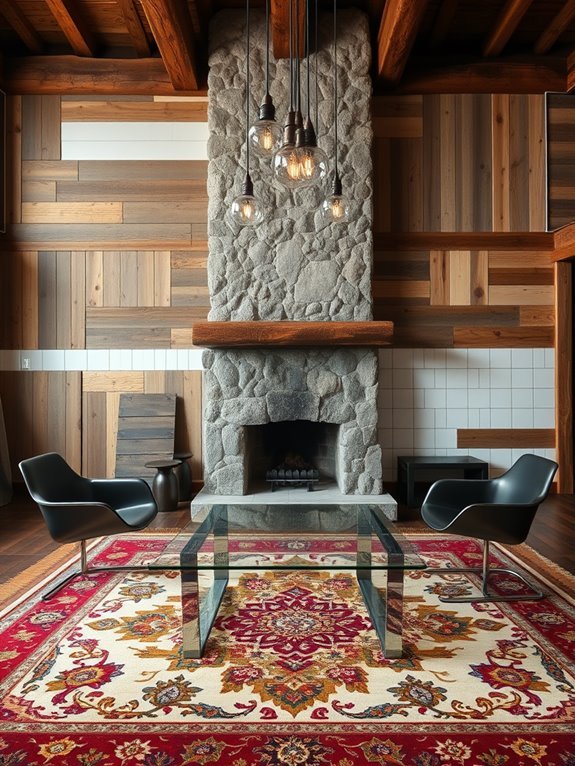
Mixing styles can create a unique look, but inconsistency disrupts harmony in a rustic interior.
Picture a space that’s part cozy cabin, part modern art gallery—like wearing a plaid shirt with polka dot pants. To blend styles, find a common thread, such as a color palette or texture.
If you have rustic wood beams, avoid sleek furniture; choose pieces that enhance warmth.
Also, consider scale: a large industrial coffee table can overshadow a delicate farmhouse chair, making the room feel unbalanced.
Match furniture in style and size for a cohesive look.
Ignoring Outdoor Connections
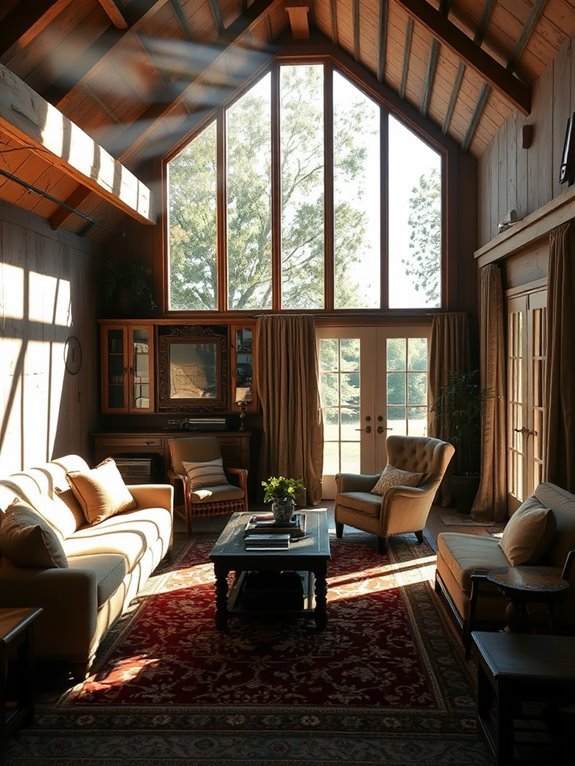
Incorporating outdoor elements can enhance your rustic interior, akin to a cozy cabin nestled in the woods. Ignoring these connections means missing out on the beauty and warmth they offer.
Here’s how to integrate the outdoors into your rustic design:
- Natural Materials: Use wood, stone, or woven fibers to reflect outdoor textures, creating a grounded and inviting space.
- Houseplants: Add greenery with easy-to-care-for plants like succulents or ferns to purify the air and enliven your space.
- Natural Light: Install large windows or glass doors to let sunlight flood in, making your home feel open and airy.
- Outdoor Living Areas: Extend your home with an outdoor patio and rustic furniture, perfect for morning coffee or evening relaxation.
Relying Solely on Trends
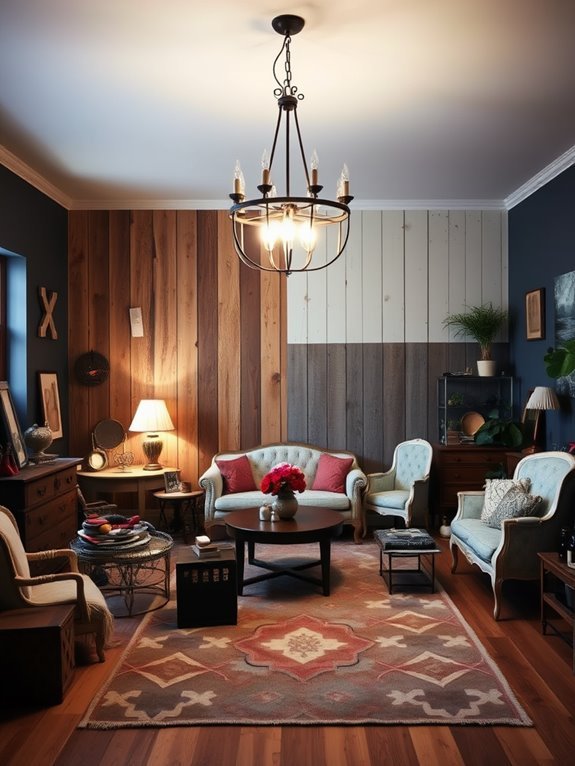
Relying solely on trends can make a rustic interior feel like a showroom rather than a cozy retreat. Trendy features like shiplap walls and farmhouse sinks may look great online, but constantly chasing fads can strip your space of personality. Your home should reflect who you are, not just the latest Pinterest board.
Instead of following every trend, focus on what truly resonates with you. Opt for elements that bring warmth and comfort, like a well-worn leather couch or handmade wooden accents. These pieces add character and charm to your space. Trends are fleeting, but your love for rustic design should endure.
Don’t forget to mix styles! Blending vintage finds with trendy touches can create a balanced, unique look. It’s about finding the perfect balance between what’s in vogue and what feels authentic to you.
Embrace the rustic spirit and let your personal style shine—your home should be a retreat, not a runway!
Overlooking Lighting Choices
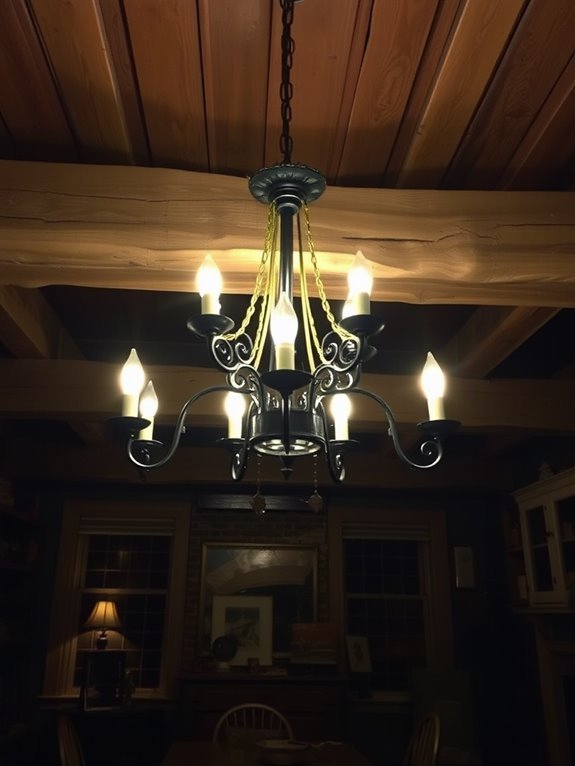
Consider how lighting can transform your rustic space. The right lighting can mean the difference between a cozy haven and a dark cave.
Here are four lighting choices to enhance your space:
- Layered Lighting: Use ambient, task, and accent lighting for depth. Combine chandeliers for overhead glow with table lamps for cozy reading corners.
- Natural Light: Maximize windows with sheer curtains for a warm, inviting atmosphere.
- Warm Bulbs: Soft, warm bulbs enhance the rustic vibe, avoiding harsh, cold light.
- Decorative Fixtures: Choose vintage or handmade fixtures for rustic charm and conversation starters.
Underestimating Maintenance Needs
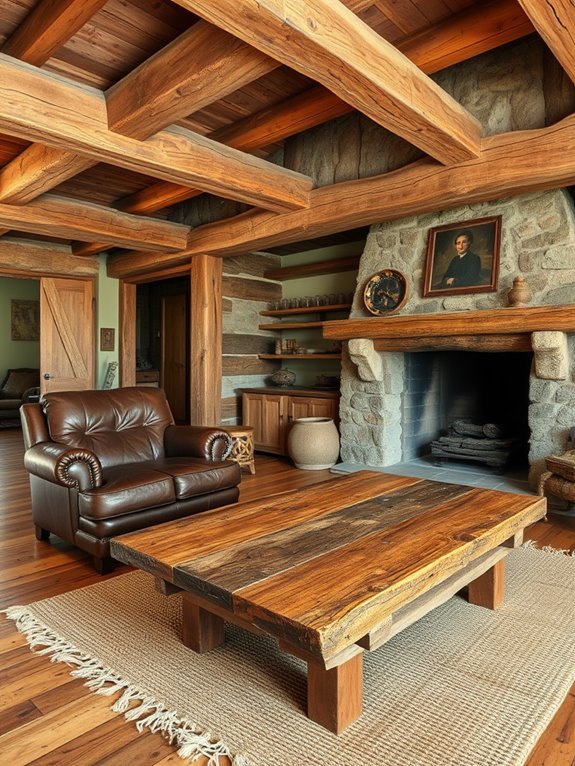
Rustic interior design captivates with natural materials and cozy aesthetics, but neglecting maintenance can be costly.
While that reclaimed wood table is stunning, it requires regular oiling to stay fresh.
Rustic elements like stone, wood, and textiles demand specific upkeep routines.
Cleaning a jute rug or protecting an antique sofa from spills requires careful attention.
Maintenance is essential to preserving rustic charm, not just a chore—it’s about showing your space some love.
Cluttering Open Spaces
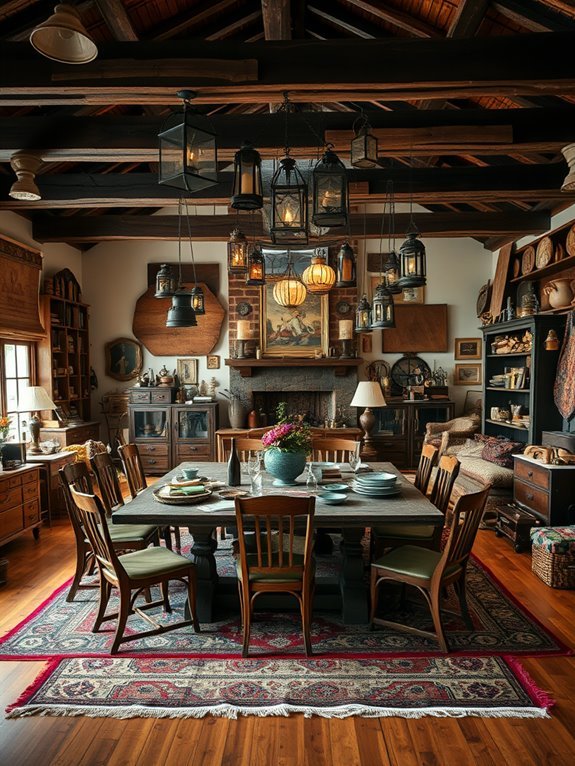
Open spaces are key to rustic design, offering freedom and airiness, but they can become cluttered.
To keep them inviting and not chaotic, try these tips:
- Limit Furniture: Select a few key rustic pieces, like a wooden table or cozy sofa, and avoid overfilling the space.
- Use Multi-Purpose Items: Opt for furniture that serves multiple functions, such as a storage ottoman.
- Create Zones: Organize space by designating areas for activities like reading or entertaining.
- Declutter Regularly: Periodically review your decor and remove items you no longer use.
These tips will help maintain the beauty of your rustic retreat!
Failing to Personalize
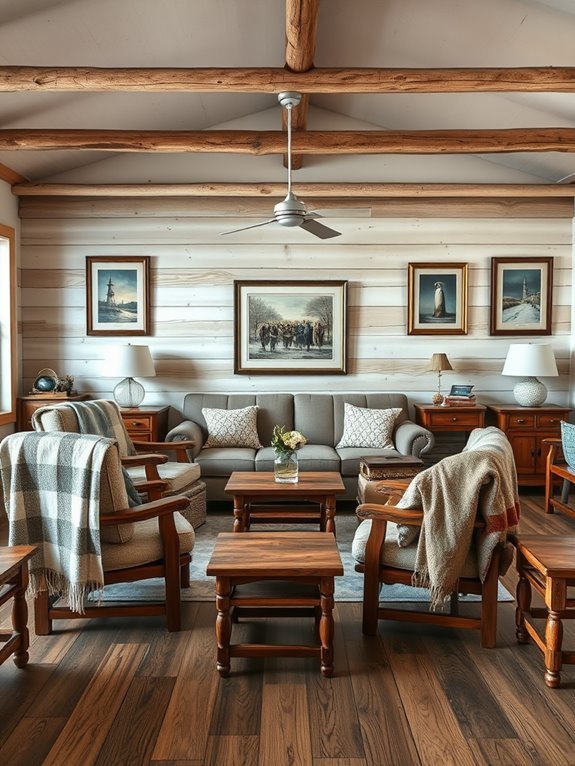
To truly make a rustic interior feel like home, avoid the mistake of not personalizing your space.
While wood beams and cozy textiles set the mood, adding personal touches like family photos, travel souvenirs, or handmade crafts adds warmth and character.
Don’t hesitate to mix in your favorite colors or quirky decor, as it’s your home. A bit of humor also helps—try a funny quote on wall art or a whimsical trinket.
Personalizing your space not only makes it comfortable but also tells your story.
Unleash your creativity—your home deserves it!
Frequently Asked Questions
How Can I Incorporate Modern Elements Into Rustic Design?
You can blend modern elements into rustic design by adding sleek furniture, minimalist decor, and contemporary lighting. Use neutral colors and geometric patterns to create balance, ensuring the space feels fresh while still maintaining its cozy charm.
What Are the Best Materials for Rustic Furniture?
When you think rustic, envision warmth and rugged charm. For furniture, use reclaimed wood for authenticity, metal accents for durability, and natural fibers for comfort. These materials blend beautifully, creating a cozy, inviting atmosphere.
How Do I Choose Artwork for a Rustic Space?
When choosing artwork for your rustic space, focus on nature-inspired themes or local landscapes. Incorporate earthy colors and textures that complement your furniture, and select pieces that evoke warmth and a sense of history.
What Lighting Fixtures Complement Rustic Interior Design?
To complement rustic interior design, choose warm-toned pendant lights, opt for wrought iron fixtures, and incorporate soft, glowing lamps. Mixing textures, using natural materials, and embracing vintage styles will enhance your space’s cozy charm.
How Can I Make a Small Space Feel Rustic?
To make a small space feel rustic, use warm colors, natural materials, and cozy textiles. Incorporate wooden furniture, vintage decor, and soft lighting. Don’t forget to keep the space uncluttered for a more inviting atmosphere.
Conclusion
Avoiding rustic design pitfalls sets you up to create a cozy and balanced haven. Let your personality shine, embrace quirks, and don’t sweat the small stuff. With thoughtfulness, your space will become a charming, clutter-free retreat.

